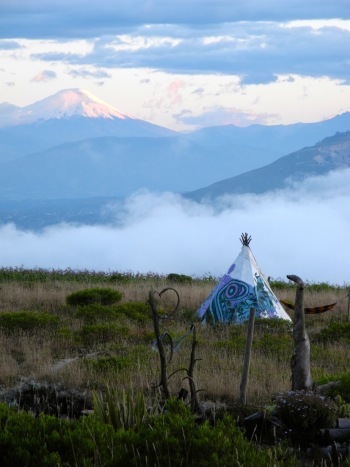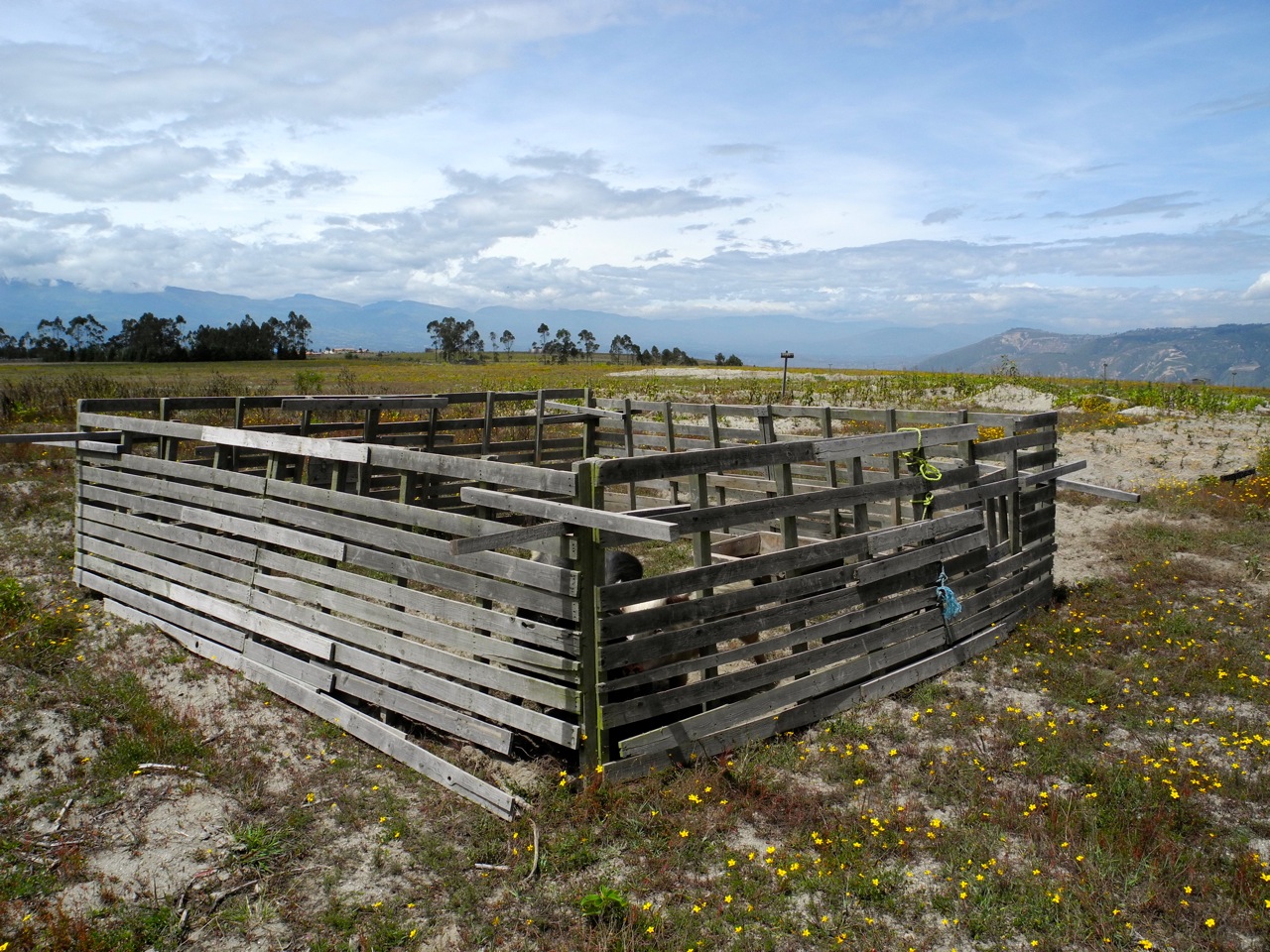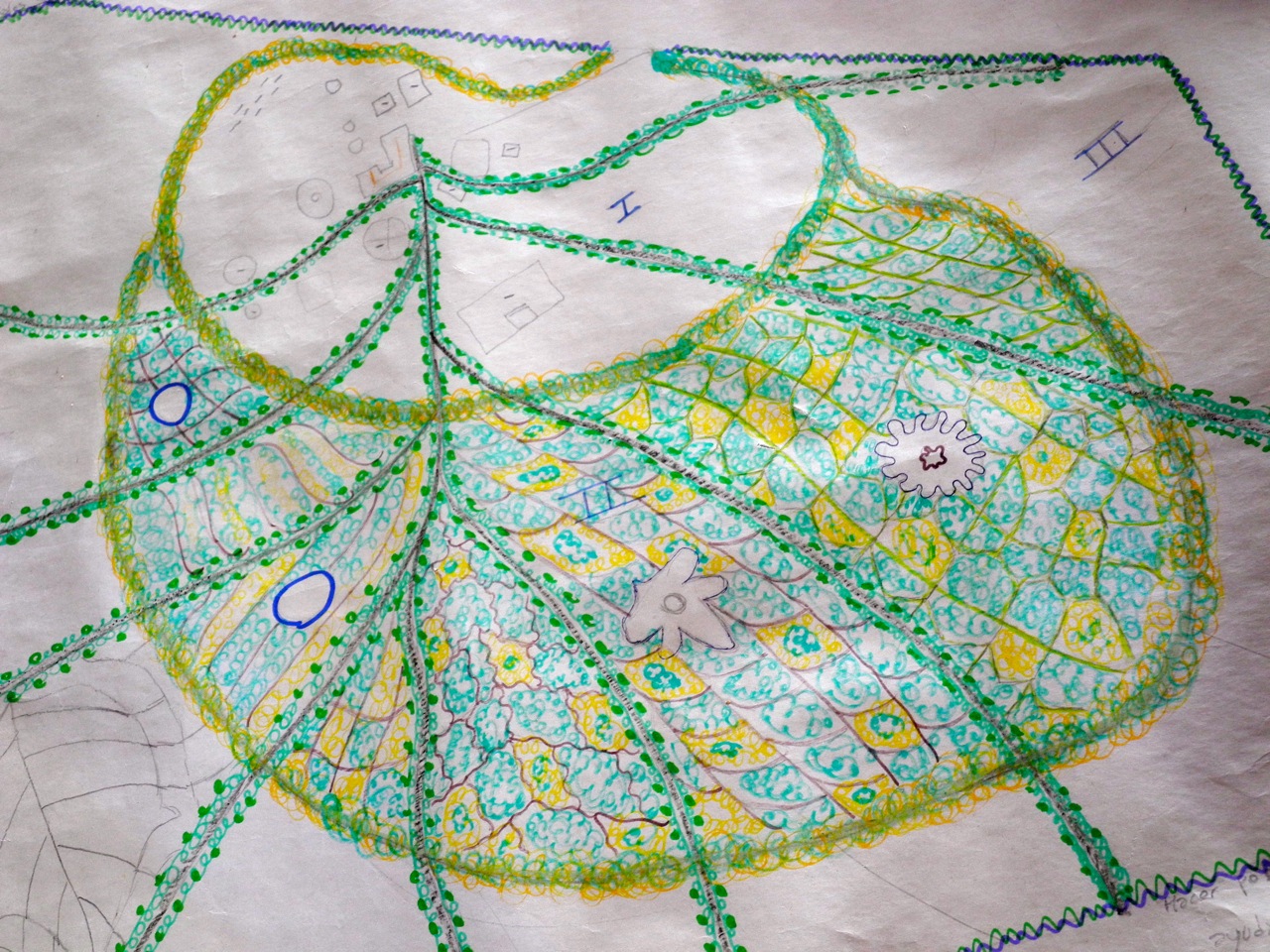The Idea of an Ecovillage
 Tuesday, May 17, 2011 at 08:07PM
Tuesday, May 17, 2011 at 08:07PM Post by John Michael
 Teepee and Cotopaxi: A teepee, which is part of the housing at Comuna de Rhiannon, sits in the foreground, while volcano Cotopaxi looms behind.
Teepee and Cotopaxi: A teepee, which is part of the housing at Comuna de Rhiannon, sits in the foreground, while volcano Cotopaxi looms behind.
There are many opportunities to create systems that work from the elements and technologies that exist. Perhaps we should do nothing else for the next century but apply our knowledge. We already know how to build, maintain, and inhabit sustainable systems. Every essential problem is solved, but in the everyday life of people this is hardly apparent.
Permaculture: A Designer’s Manual by Bill Mollison
I’ve heard a lot about sustainability, and I know that it’s a good thing, but I’ve rarely seen it in practice, and never to the extent that it’s practiced here, at Comuna de Rhiannon, a farming commune located within the Andes Mountains, and about an hour to the north of the Ecuadorian capital of Quito. Sustainability is the operating idea at Comuna de Rhiannon, and it governs the fate of everything that lives within the commune’s boundaries, from the hogs that are used to till Rhiannon’s soil, which is rich in volcanic ash, as the farm is surrounded by several volcanoes, to the food that is leftover from meals, which is either used as animal feed or as compost, depending upon what it is. Sustainability is such an integral part of the culture at Comuna de Rhiannon that on my third day here I found myself being teased by two young British men, who were residents of the commune at the time, because I had double-spaced my texts before printing them, and because I did not print on both sides of a sheet of paper. “That’s not at all sustainable, John,” chided Will. “No, absolutely not,” agreed Rob, who punctuated his statement by shaking his head in tongue-in-cheek disappointment. But, instead of reacting with annoyance, as I tend to do when I’m teased, I was pleasantly intrigued by the exchange, because it was the first time that I’d ever been teased about my sustainability. In fact, it was the first time that I’d ever heard of anyone being teased about their sustainability, and I began to wonder whether the culture of sustainability on display at Comuna de Rhiannon was a sign of the things to come in both Western Culture and, perhaps, Global Culture at large.
“It was just in 1986 when we first went past the earth’s capacity, and we’ve been exceeding this capacity ever since. This means we are using up our capital every day now just to survive.” So writes Paul Gilding in his book The Great Disruption, which contains a warning of the impending collapse of ecosystems worldwide. In order to survive the coming Great Disruption, Gilding writes, human beings will have to reform their unsustainable economic practices. Comuna de Rhiannon might just offer us a glimpse of what these reformed practices might look like should things unfold as Gilding warns us that they will. Founded three years ago, Comuna de Rhiannon has since been working toward becoming a self-sustaining community, and specifically one that does not pollute the environment in which it is established in any way, which is to say that Comuna de Rhiannon currently aspires to become an ecovillage.
The idea of an ecovillage takes the traditional concept of the commune, which is a self-contained settlement that has no need of resource input from the outside world, and makes it environmentally sound. Underlying this transformation is the farming philosophy of Permaculture, which attempts to move away from the modern practices of monoculture farming, in which one crop is intensively cultivated on a plot of land, with the use of pesticides and fertilizers to guarantee that large harvests will be generated in the short term, while also guaranteeing that the land utilized in this manner will in the long term be exhausted of its nutrients and therefore of its capacity to grow crops. Permaculture advises farmers to cultivate their land in a manner that most closely approximates a natural, uncultivated landscape. Bill Mollison, in his 1988 textbook Permaculture: A Designer’s Manual, envisions the transformation of monoculture farms into permaculture havens as a movement from monotonous rows of a single crop stretching to the horizon, towards a farm that cultivates a wide variety of plants, and which appears to be more of a giant garden than what we might recognize as a farm, utilizing the natural processes inherent in ecosystems to both increase the farm’s productivity and to ensure its fertility in the long term.
 The Pig Tractor: This wooden pen, which contains three full-grown pigs, is moved across the fallow land at Communa de Rhiannon, allowing the pigs to effectively clear and plough the soil. Once the land is tilled by these pigs, crops are planted upon it.
The Pig Tractor: This wooden pen, which contains three full-grown pigs, is moved across the fallow land at Communa de Rhiannon, allowing the pigs to effectively clear and plough the soil. Once the land is tilled by these pigs, crops are planted upon it.
At Comuna de Rhiannon, permaculture techniques are employed in an attempt to turn the relatively arid and basically treeless land that the commune inhabits into an Eden-like landscape. Young fruit trees have been planted in various orchards situated throughout the property in the hopes that one day, and in spite of the constant and dry wind that scours this land, they will grow to provide the farmers passing through with fruit which they can pick by hand. Swales, which are shallow ditches meant to collect water for the plants growing on the higher land on either side of them, are being dug along the contours of the property in order to catch rainwater and to trap it in the soil of the farm. Following the principle of permaculture that encourages farmers to allow nature to perform most of the work of farming, the soil of Rhiannon is tilled by animals, with volunteers moving the pig pen, also known as the “pig tractor,” every morning so that the pigs can eat the weeds growing on the fallow land where their pen is located, and then turn the soil in their search for edible roots and also enrich it with their manure. The soil at the commune is protected from both wind and water erosion by the swales and by the trees planted upon them. While the trees are still young, as most of them currently are at Rhiannon, wind walls are built around them to protect them as they grow, and these wind walls are generally built from wooden stakes taken from the old woodpile and plastic sacks taken from the recycling bin. Materials are almost always recycled at Comuna de Rhiannon, and even rusty nails are kept in the hopes of finding a second use for them. While I was at the farm, a glass windowpane in my dormitory was broken by the wind, and was subsequently replaced by a windowpane woven from strips of tetrapack created by cutting up discarded boxes of wine. Even the water used in the sinks and showers at Comuna de Rhiannon is recycled, sent after its first use toward a small lagoon in the center of the property where it is purified both by water lilies and by other marsh plants. The presence of this lagoon has, in only a few months, attracted a wide variety of butterflies and birds, filling the air of the commune with the colorful fluttering of butterfly wings, and with the sweet melody of birdsong.
 Comuna de Rhiannon: In this overhead blueprint of Comuna de Rhiannon drawn by a traveling permaculture enthusiast from Argentina, the light brown lines covered in green and yellow swirls represent the swales, while the dark brown lines lined by green dots represent tree-lined trails that are meant to traverse the property while providing protection from the wind for the cultivated areas.
Comuna de Rhiannon: In this overhead blueprint of Comuna de Rhiannon drawn by a traveling permaculture enthusiast from Argentina, the light brown lines covered in green and yellow swirls represent the swales, while the dark brown lines lined by green dots represent tree-lined trails that are meant to traverse the property while providing protection from the wind for the cultivated areas.
Coming to Rhiannon was a bit of a shock for me, for no other reason than that the commune’s culture of sustainability brought me face to face with the fact that my own culture of disposability, in which the products that I consumed to support my life were used and then were thrown away, never to be considered again, was founded upon an illusion, the illusion that the objects that I discarded would disappear from my life, and would then cease to affect me entirely. But at Rhiannon I was able to see that the objects that entered my life came from the land, and when I was finished with them, they returned to the land. Of course I had been aware of this reality before, but in our American culture of disposability, the extraction of the resources that compose the products which we consume occurs outside of the daily lives of most of us, and the processes that create the products that we use are similarly hidden from us, as is the ultimate fate of those products once we dispose of them. Being a part of the processes that created the products that sustained my life at Comuna de Rhiannon allowed me to experience the reality of production, that everything taken from the land ends up returning to it, and that the health of this land called Earth that sustains us all is entirely dependent upon what we take from it, and upon what we give back to it.
There is too much contemporary evidence of ecological disaster which appalls me, and it should frighten you, too. Our consumptive lifestyle has led us to the very brink of annihilation. We have expanded our right to live on the earth to an entitlement to conquer the earth, yet “conquerors” of nature always lose. To accumulate wealth, power, or land beyond one’s needs in a limited world is to be truly immoral, be it as an individual, an institution, or a nation-state.
Permaculture: A Designer’s Manual by Bill Mollison


Reader Comments (2)
a thoroughly enjoyable read John, I'm glad to hear that you learnt so much. Enjoy the rest of your travels.
Thanks, Rob! Same to you!